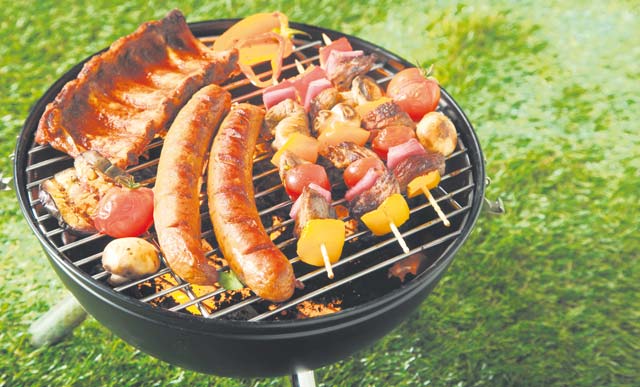
The smell of barbecue continues to linger through the air during the summer months. Before you fire up the grill this year, consider what options you might have to make it a healthy, as well as satisfying fun experience.
According to the dietary guidelines for Americans 2010, a healthful diet should include fruits, vegetables, whole grains and low-fat or fat-free dairy products. It should also contain lean meats, poultry, fish, beans, eggs and nuts. The guidelines also suggest limiting saturated fats, trans fats, cholesterol, salt and added sugar. These should also be done in conjunction with ensuring that one does not exceed their recommended caloric intake.
Healthy eating practices should be included as part of our plan to stay ready and resilient. The Performance Triad recognizes that proper nutrition is an integral part of ensuring that our community enjoys a great quality of life.
Having a healthy meal and a delicious meal are not mutually exclusive. Healthy cooking techniques such as grilling can capture the flavor of foods without adding extra calories. According to a Botsford registered dietician, the high heat from the grill preserves the foods moisture thereby keeping it tender. This eliminates the need to add oil or butter during cooking and makes you less reliant on sauces or other condiments to enhance flavor. To ensure that the meat is cooked thoroughly, baking meat covered in the oven before cooking on the grill may assure food is cooked to a safe temperature. This suggestion is, however, not necessary to achieve the specified internal temperature, especially for the seasoned griller or outdoor chef. These methods are great ways to reduce the fat content of meals without sacrificing taste or food safety.
The high heat from grilling also causes excess fat on meats to drip off, thereby lowering the fat content of the meat itself. It is important to remember, however, that the addition of sour cream, butter, sauces and toppings add fat and calories to the meal and should be used sparingly or in moderation so it does not counteract the benefits of this cooking practice. Certain cuts and types of meat are also higher in fat than others.
During the summer, the Centers for Disease Control recommends choosing leaner options such as skinless chicken or turkey, fish and lean pork. Using the chicken breast is also a lower-fat option than darker meats such as the thigh or leg. While the summer is still here, try to cut back on the fats in some of the aforementioned ways if you choose to enjoy ribs, steaks, brats and hamburgers. When making condiments and sauces, utilize some of the great European options available. For example, make low-fat or non-fat yogurt dressings instead of mayonnaise-based sauces and dressings to cut calories.
Healthy eating also encompasses eating a variety of foods from the different food groups. Fruit and vegetables can be prepared on the grill as well as being part of meals as a side dish. Shish kebabs are a fun way to incorporate fruits and vegetables on the grill. When they are grilled, they tend to retain more of their vitamins and minerals. Buying fruits and vegetables that are in season also ensures that your friends and family are getting the freshest produce at better prices. Be creative and research ways to incorporate some of the local fruits and vegetables available in Germany that may not be familiar — they may be well worth the experiment.
Variety is the spice of life, so enjoy the different foods that can be part of any summer celebrations. Remember to eat in moderation, and always practice safety when cooking outdoors on the grill.


